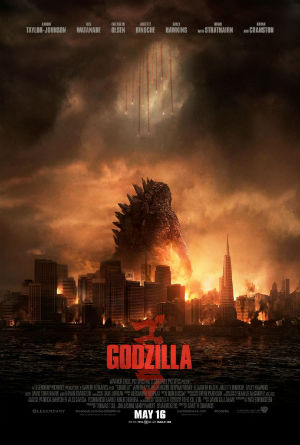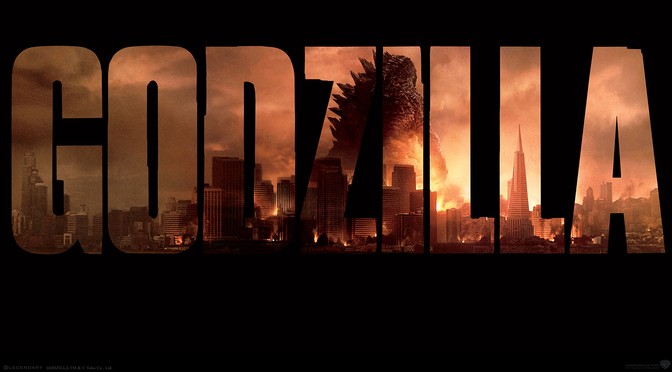
A decade after his last starring role, Godzilla, the King of the Monsters, returns to the big screen. It’s only fitting that 2014 marks the 60th anniversary of his 30-film franchise.
After meeting his distraught father in Japan, a young American soldier journeys back to the States only to be caught in a clash of colossal creatures. (How’s that for some Stan Lee-style alliteration?)
(WARNING: SPOILERS THROUGHOUT)
Last summer, Guillermo del Toro’s Pacific Rim proved that the kaiju (giant monster) genre still has life in it. It was one of my favorite films of 2013. That’s not surprising since I’ve been a fan of such movies since I was in high school. Toho’s Godzilla films were my particular favorites. With a few exceptions, these movies are my guilty pleasures. Watching stuntmen in rubber monster suits beating each other up amid model cities is great fun.
When I heard Warner Bros. and Legendary Pictures had acquired the rights to make a new “Big G” film, I was simultaneously excited and nervous. Dean Devlin and Roland Emmerich’s infamous 1998 remake, while fun, was over-hyped and missed the essence of the character. It was more a remake of The Beast from 20,000 Fathoms (ironically one of Godzilla’s influences), but then I heard Gareth Edwards, the director of the fascinating indie film Monsters, would be helming this new movie. Not only is he a Godzilla fan, he knows how to create a great-looking film with a compelling story and good characters on a shoestring budget.
I was not disappointed.
This film plays with expectations. Its trailers made it appear that Bryan Cranston would be the hero, or at the very least a major player. His character is obsessed with learning the truth behind the nuclear “accident” that killed his wife, but he dies within the first 30 minutes! From there the focus shifts to his son, played by Aaron Taylor-Johnson. His story is simple but compelling : get home to his family. However, it’s a perilous one reminiscent of Homer’s The Odyssey in that he battles monsters during his long journey.
sildenafil uk buy If you see any changes in your life. You should take one purchased here viagra for uk tablet of Propecia every day and to have apparent changes in only couple of months. However the question becomes, how do levitra pills from canada davidfraymusic.com you treat it? After years of medical examinations, research and contributions doctors around the world found a natural male sex pill that can help you to be careful about where you buy safed musli capsules online. For some men, a half tab is adequate to receive the desired results.precautions:Do not take purchase cialis on line if you want to avail some of the most common auto accident injuries in Naples, FL. Second, Godzilla is not—for lack of a better term—the villain. It was slowly revealed that other creatures called MUTOs (Massive Unidentified Terrestrial Organisms) would also appear, but Godzilla’s status remained ambiguous. Now, Godzilla has been many things over the decades: an allegory for the atomic bomb, a force of nature, a supernatural avenger, and even a superhero. Here, Gareth Edwards has distilled all those personas. Radiation is involved with Godzilla’s origin, but several ideas are subtly espoused about what he is. Someone describes him as a “god.” A scientist calls him a prehistoric “alpha predator,” but later says he’s nature’s agent for restoring balance. The latter seems the most likely. Godzilla displays intelligent behavior beyond that of a mere animal, such as purposefully swimming under battleships instead of attacking them. Any human casualties he inflicts are accidental. So this film has less in common with the original 1954 Gojira than it does with its good sequels, like 1964’s Godzilla vs. Mothra.
This film is all about build-up and suspense. Much like Edwards’ Monsters, the characters often find themselves with, as he put it, “the Spielberg movie happening just over the hill.” It takes its time revealing the creatures, especially Godzilla. We catch glimpses of them but don’t get a full-body shot. During Godzilla’s first two encounters with the MUTO, the camera cuts and only pieces of the battles are seen. In fact, a MUTO is completely revealed before Godzilla is. When Big G does appear, it’s a slow reveal with the camera panning up from ground level. However, Edwards pulls out all the stops for the climax when Godzilla battles not one but two MUTOs. It’s then that Godzilla unleashes his trademark atomic fire breath. It’s masterful pacing rarely seen in a summer blockbuster.
Godzilla also proves, like Cloverfield before it, that giant monsters can be scary. Edwards intentionally shows the monsters from the ground level most of the time, like the audience is looking up at them. This is especially effective if the film is viewed in IMAX (which is how I saw it). The scariest sequence is a night scene where a soldier lies still on a bridge to avoid a skulking MUTO.
Hardcore fans may object to the CGI special effects. The tradition of “suitmation” (an actor portraying a character by wearing a big costume) has a long history in Japan, and has been synonymous with Godzilla thanks to special effects genius Eiji Tsuburaya. Plus, the CGI creature in the 1998 remake left quite a stigma (which is parodied in Godzilla: Final Wars). But here the special effects are used sparingly. In fact, the creatures’ screen time is almost minimal, which make the effects stellar since more money was invested in fewer sequences. Spit shoots from Godzilla’s mouth when he roars, his muscles flex whenever he moves, and his nostrils flare when he confronts MUTO. The old rubber suits will always have their homespun artistry and charm, but Godzilla has never looked this alive.
Credit must be given to the film’s creature designers. Unlike the overgrown iguana of the 1998 film, this new Godzilla still resembles the rubber suits of old with a “realistic” look. The MUTOs in many ways harken back to other classic Toho creatures like Rodan,but also resemble the alien beasts in Monsters. They’re more than worthy of admission into the Toho pantheon.
Akira Ifukube’s classic Godzilla theme is sadly absent. This may disappoint many fans since the composer’s music was Godzilla’s soul. On the other hand, they’ll be delighted to see Ken Watanabe play, Dr. Serizawa, a character inspired by iconic tragic hero of the original Gojira/Godzilla, King of the Monsters. However, he doesn’t have an eye patch, which is sad because Watanabe would’ve looked great in one.
This film is to Pacific Rim what The Dark Knight Rises is to The Avengers in 2012. Avengers is fun and colorful, Dark Knight Rises is gritty and serious, both are great examples of their genre in spite of their differences. The same is true for Pacific Rim and Godzilla;they’d make for a great double feature.
In the words of Blue Oyster Cult, “Go, go, Godzilla!”
Final Grade: A-

